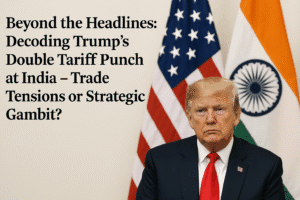Beyond the Headlines: Decoding Trump’s Double Tariff Punch at India – Trade Tensions or Strategic Gambit?
President Trump imposed an immediate 25% tariff on all Indian goods, citing longstanding frustrations over India’s “obnoxious” trade barriers and the $45.7 billion US trade deficit. Crucially, he added an unprecedented “penalty” targeting India’s strategic Russian energy and defense imports – a dangerous escalation weaponizing trade policy for geopolitical coercion. Announced just days before August implementation and weeks before critical trade talks, this dual move is a high-pressure tactic to force Indian concessions.
Beyond economics, it reflects US anxiety over India’s BRICS role and perceived “attack on the dollar.” India faces a tightrope walk: balancing vital Russian ties against severe export damage to sectors like pharma and gems, while signaling no capitulation but openness to fair negotiation. This sets a perilous global precedent where trade becomes a tool for political punishment, accelerating the fragmentation of international trade rules.

Beyond the Headlines: Decoding Trump’s Double Tariff Punch at India – Trade Tensions or Strategic Gambit?
President Trump’s abrupt announcement of a 25% tariff on all Indian goods, coupled with an unprecedented “penalty” for India’s Russian energy and defense imports, isn’t just another trade spat. It’s a high-stakes move with profound implications for global trade architecture, geopolitical alliances, and India’s economic strategy. Here’s the deeper analysis:
- The Core Grievance: “Obnoxious” Barriers & The Deficit Trump’s core complaint, echoed for years, centers on India’s historically high tariffs and complex non-tariff barriers (like stringent quality standards and localization requirements) that limit US market access. The $45.7 billion US goods trade deficit in 2024 is his primary metric for “unfairness.” While economists debate the simplistic view of deficits as losses, the perception drives US policy. India’s recent willingness to negotiate cuts (seen in talks with the UK and ongoing US discussions) wasn’t enough to forestall this action.
- The Unprecedented “Russia Penalty”: A Dangerous New Tool This marks a radical escalation. The penalty isn’t about Indian goods harming US industries (the traditional justification for tariffs). It’s a secondary sanction – punishing India for its sovereign choices in buying Russian oil and arms. This weaponizes trade policy for geopolitical coercion, setting a perilous precedent. It directly targets India’s energy security (Russia now supplies 35-40% of its crude) and its decades-old, strategically vital defense relationship with Moscow. The size of the penalty remains critical, but its mere existence signals a willingness to blur lines between trade and foreign policy sanctions.
- Timing is Everything: Pressure Tactics Ahead of Crucial Talks Announcing this just two days before the August 1st deadline for his broader reciprocal tariffs, and crucially, weeks before US officials were due in Delhi for the next round of trade talks (August 25th), is no coincidence. It’s a deliberate, high-pressure tactic. White House adviser Kevin Hassett explicitly framed it as Trump’s frustration boiling over, believing it would “help the situation.” The goal is clear: force India to make significant concessions – likely on agricultural market access (a US priority), digital trade, and medical devices – or face immediate economic pain.
- The Geopolitical Subtext: BRICS, Dollars, and Alignments Trump’s offhand remark about BRICS being “an attack on the dollar” reveals a deeper anxiety. While BRICS’ de-dollarization ambitions are nascent, the US views any challenge to dollar hegemony as a strategic threat. India’s active participation in BRICS, combined with its continued Russian ties, feeds a narrative in some US circles of Delhi being an unreliable partner, despite the “friend” label Trump uses. This tariff move serves as a stark warning about the perceived costs of strategic hedging.
- India’s Tightrope Walk: Balancing Sovereignty, Security & Trade India’s response has been measured but firm. The Commerce Ministry emphasized commitment to a “fair, balanced” deal protecting Indian farmers and MSMEs, and readiness to take “all steps necessary” to secure national interests. This signals: * No Capitulation: India won’t abandon Russian energy/defence ties under duress; they are core to energy affordability and military readiness. * Potential Retaliation: India has its own list of US imports it could target (agricultural products, machinery, aircraft). * Focus on Negotiation: Despite the provocation, Delhi seems to prefer keeping the talks alive, viewing a deal as preferable to a tariff war, but only on acceptable terms.
The Real Human Impact & What Comes Next:
- Indian Exporters in the Crosshairs: Key sectors like pharmaceuticals (drugs, formulations), gems & jewellery, textiles, and engineering goods face an immediate 25%+ cost disadvantage in their largest market. Job losses and factory slowdowns are a real risk.
- Global Trade Fragmentation: This move accelerates the breakdown of rules-based multilateral trade (exemplified by the crippled WTO). The rise of punitive, politically-motivated tariffs and secondary sanctions creates immense uncertainty for businesses worldwide.
- The Test of the “Friendship”: Trump’s rhetoric of friendship clashes starkly with aggressive unilateral action. PM Modi faces immense pressure domestically to respond firmly. The upcoming August 25th talks, if they proceed, will be tense. Can a deal be salvaged, or is this the start of a protracted economic conflict?
- A Global Warning: Other nations heavily trading with Russia (like China, Turkey, Vietnam) are now on notice. The US has demonstrated it’s willing to use trade penalties as a geopolitical cudgel beyond traditional sanctions regimes.
Trump’s double tariff is more than a trade dispute; it’s a strategic gambit with global ramifications. It pressures India economically to bend on trade terms and geopolitically to align more closely with US objectives against Russia. India’s response will define not only the future of a crucial bilateral economic relationship but also signal how effectively middle powers can navigate an increasingly volatile world where trade is weaponized. The coming weeks, starting with the August 1st tariff implementation and the crucial late-August talks, will be pivotal. The path forward hinges on whether pragmatism can overcome punitive posturing.
You must be logged in to post a comment.